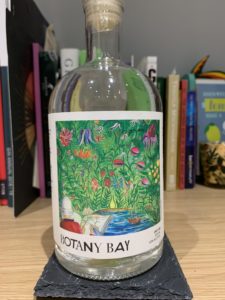 Nearly 18 months ago I was excited to collect the keys to my new home. I was excited because at said new house was a bottle of the Four Pillars x Herno collaboration, Dry Island gin (which, if anyone is interested, is one of my favourites ever). For that gin, the Four Pillars team incorporated some of Herno’s key botanicals into their process. Today, we try Botany Bay, the next release which sees Australian botanicals make their way to Sweden to join Herno’s distillation. Fun story: the first Swede to circumnavigate the world was botanist Dr. Daniel Solander who was so taken with the variety of flora he found down under that he named the landing spot Botany Bay. Inspired by this history, Herno uses their signature botanicals meadowsweet and lingonberry and combines them with Australian wattleseed, Tasmanian pepper berry and lemon myrtle. Before we taste the gin, I think we should just take a moment to appreciate the label which ignores Herno’s simple label tradition and is a bright, colourful picture of Dr Solander’s adventure (Dry Island had a label very in line with Four Pillars’ branding). So, do the contents live up to the label’s (and its predecessor’s) standards?
Nearly 18 months ago I was excited to collect the keys to my new home. I was excited because at said new house was a bottle of the Four Pillars x Herno collaboration, Dry Island gin (which, if anyone is interested, is one of my favourites ever). For that gin, the Four Pillars team incorporated some of Herno’s key botanicals into their process. Today, we try Botany Bay, the next release which sees Australian botanicals make their way to Sweden to join Herno’s distillation. Fun story: the first Swede to circumnavigate the world was botanist Dr. Daniel Solander who was so taken with the variety of flora he found down under that he named the landing spot Botany Bay. Inspired by this history, Herno uses their signature botanicals meadowsweet and lingonberry and combines them with Australian wattleseed, Tasmanian pepper berry and lemon myrtle. Before we taste the gin, I think we should just take a moment to appreciate the label which ignores Herno’s simple label tradition and is a bright, colourful picture of Dr Solander’s adventure (Dry Island had a label very in line with Four Pillars’ branding). So, do the contents live up to the label’s (and its predecessor’s) standards?
blog
Boatyard Double gin
Note: This post contains affiliate links marked as [Ad], if you click on this and buy a bottle of gin then I will receive a small commission.
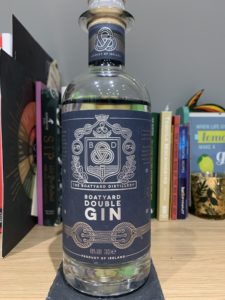
There’s been a lot of talk in the recent months about the rise in Scottish gin, but today we head across the water to the north west coast of Ireland. Boatyard Distillery is based on the banks of Lough Erne in their farm-to-bottle distillery. Their vodka is made from home-grown wheat, the spent grains go back to the land as fertiliser and animal food, and they pick their signature gin botanical (Sweet Gale – a type of bog myrtle) is picked from the family bog. Today’s drink is their flagship Double Gin, made by macerating eight botanicals for 18 hours in their wheat spirit and ensure the juniper flavour is front and centre using a filtration process which helps to highlight the beautiful pine notes. They keep their botanical list fairly traditional – alongside the juniper is coriander, liquorice root, angelica, orris, fresh lemon peel, grains of paradise and the aforementioned Sweet Gale. So, how does the banks of Lough Erne taste?
Gŵyr Rhamanta gin
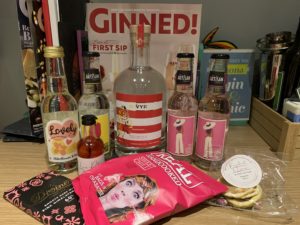 As you’ll probably know if you read my blog, I am a long time member of Craft Gin Club. My next delivery is due in March, but when I saw the announcement that February’s box is an exclusive release from Gŵyr, I had to get myself a box. The newest member of the family is a Valentine’s special featuring their distinct foraged wild fennel alongside pomegranate seeds, red rose petals and fresh pink grapefruit zest. The label may be pink, but the gin isn’t. Rhamanta has two meanings: the first is an old Welsh tradition of divining your romantic future, and the second is the translation “be romantic”. Because what says romance more than shovelling grains of wheat over a fire to see when they pop and then commanding someone to be romantic? Siân and Andrew liked the idea of “romance” counting as the act of sharing your gin with your partner, friends and family – sharing gin love is the best type of romance. Made in their distillery at the bottom of their garden, surrounded by their family (who are the team), over looking the sea, this gin also helps celebrate the couple’s 30th anniversary. Let’s raise a glass to Brooks’ and see how it tastes.
As you’ll probably know if you read my blog, I am a long time member of Craft Gin Club. My next delivery is due in March, but when I saw the announcement that February’s box is an exclusive release from Gŵyr, I had to get myself a box. The newest member of the family is a Valentine’s special featuring their distinct foraged wild fennel alongside pomegranate seeds, red rose petals and fresh pink grapefruit zest. The label may be pink, but the gin isn’t. Rhamanta has two meanings: the first is an old Welsh tradition of divining your romantic future, and the second is the translation “be romantic”. Because what says romance more than shovelling grains of wheat over a fire to see when they pop and then commanding someone to be romantic? Siân and Andrew liked the idea of “romance” counting as the act of sharing your gin with your partner, friends and family – sharing gin love is the best type of romance. Made in their distillery at the bottom of their garden, surrounded by their family (who are the team), over looking the sea, this gin also helps celebrate the couple’s 30th anniversary. Let’s raise a glass to Brooks’ and see how it tastes.
TOAD Oxford Dry gin
 Fun story: my first proper job out of university was working in marketing and events for entrepreneurs and investors. Obviously I then added all my favourite people on LinkedIn. Fast forward a few years and up pops a notification from Tagore Ramoutar saying he is excited to be launching a gin. Last year at Junipalooza I went along to the TOAD (The Oxford Artisan Distillery) stand and guess who was there? We had a good catch up and he kindly gave me a sample of their Ashmolean gin. But today, thanks to Gin Kiosk’s clear out sale in December, I now have a bottle of their Oxford Dry gin. They claim to be the only distillery in the world to use ancient heritage grains in their spirits, which are grown by local, organic farms in sustainable ways. Taking inspiration from the Victorian era, the team approached South Devon Railway Engineering and some of the last British copper smiths who worked for two years to build two copper stills. Firstly, a 2,400l still named Nautilus, and secondly a 500l still called Nemo (big Jules Verne fans here) which, alongside five copper column stills, allows them the freedom to be creative. Their final recipe contains everything you would expect from a classic gin – juniper, coriander, orange and lemon peel, meadowsweet and a touch of nutmeg plus a few other botanicals, so how does it taste?
Fun story: my first proper job out of university was working in marketing and events for entrepreneurs and investors. Obviously I then added all my favourite people on LinkedIn. Fast forward a few years and up pops a notification from Tagore Ramoutar saying he is excited to be launching a gin. Last year at Junipalooza I went along to the TOAD (The Oxford Artisan Distillery) stand and guess who was there? We had a good catch up and he kindly gave me a sample of their Ashmolean gin. But today, thanks to Gin Kiosk’s clear out sale in December, I now have a bottle of their Oxford Dry gin. They claim to be the only distillery in the world to use ancient heritage grains in their spirits, which are grown by local, organic farms in sustainable ways. Taking inspiration from the Victorian era, the team approached South Devon Railway Engineering and some of the last British copper smiths who worked for two years to build two copper stills. Firstly, a 2,400l still named Nautilus, and secondly a 500l still called Nemo (big Jules Verne fans here) which, alongside five copper column stills, allows them the freedom to be creative. Their final recipe contains everything you would expect from a classic gin – juniper, coriander, orange and lemon peel, meadowsweet and a touch of nutmeg plus a few other botanicals, so how does it taste?
Hills & Harbour gin
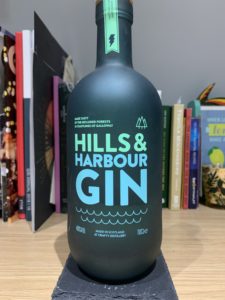 As you might have seen from previous posts, I am a big fan of Scotland and last year supported International Scottish Gin Day in August. One of the new(ish) gins coming from Scotland is Hills & Harbour gin. Hailing from Galloway (down by the border, the area is home to Gretna Green), they have a simple premise – make a gin for everyone, not just the gin snobs. This promise means they won’t charge you a month’s salary to buy a bottle (although at £40 it is definitely not the cheapest), and they won’t use poncy jargon or trendy botanicals. Using local grains, they make their own wheat base spirit as they believe this is key to the best flavour. They use 11 botanicals including Noble Fir needles (the Hills) and Bladderwrack seaweed (the Harbour) from the local area, they say the gin is juniper forward with hints of tropical fruit, citrus and “a subtle scent of the shore”. So, how does it taste?
As you might have seen from previous posts, I am a big fan of Scotland and last year supported International Scottish Gin Day in August. One of the new(ish) gins coming from Scotland is Hills & Harbour gin. Hailing from Galloway (down by the border, the area is home to Gretna Green), they have a simple premise – make a gin for everyone, not just the gin snobs. This promise means they won’t charge you a month’s salary to buy a bottle (although at £40 it is definitely not the cheapest), and they won’t use poncy jargon or trendy botanicals. Using local grains, they make their own wheat base spirit as they believe this is key to the best flavour. They use 11 botanicals including Noble Fir needles (the Hills) and Bladderwrack seaweed (the Harbour) from the local area, they say the gin is juniper forward with hints of tropical fruit, citrus and “a subtle scent of the shore”. So, how does it taste?
Gwyr Bara Brith gin
Note: The team at Gwyr kindly sent me a bottle of Bara Brith to complete the set, but as always I’ll let you know what I think.
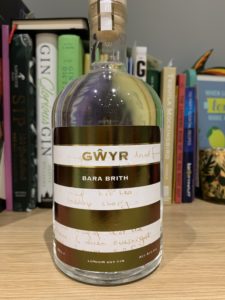 Readers of the blog will know that I am a big fan of team Gower Gin. I’ve already sipped on their Original gin, seasonal Pinwydd, and Rhosili gins, and today we try their latest addition: Bara Brith. What is Bara Brith you ask? Sometimes known as ‘speckled bread’, it is a mixture of dried fruits, brown sugar, spices and black tea, and this gin is inspired by their grandmother’s own recipe. This recipe is reproduced on their signature striped labels, and included with every order inside the reusable muslin bag. They soak the fruit in warm tea with fresh citrus, ginger, nutmeg and cinnamon before distilling it and they suggest serving it with ginger ale or with tonic and a slice of lemon.
Readers of the blog will know that I am a big fan of team Gower Gin. I’ve already sipped on their Original gin, seasonal Pinwydd, and Rhosili gins, and today we try their latest addition: Bara Brith. What is Bara Brith you ask? Sometimes known as ‘speckled bread’, it is a mixture of dried fruits, brown sugar, spices and black tea, and this gin is inspired by their grandmother’s own recipe. This recipe is reproduced on their signature striped labels, and included with every order inside the reusable muslin bag. They soak the fruit in warm tea with fresh citrus, ginger, nutmeg and cinnamon before distilling it and they suggest serving it with ginger ale or with tonic and a slice of lemon.
Copperfield A Christmas Carol gin
 December is a tricky time – well, by tricky I mean I get my Craft Gin Club delivery and because it’s Ginvent I don’t get to open my delivery until later in the month. This month we got a bumper box: four cans of Merchant’s Heart tonic, festive nuts, Pedrino sherry and tonic spritz, a bottle of cava, biscuits, winter tea, and the main event – Copperfield A Christmas Carol gin. Distilled in the Surrey hills, husband and wife team Chris and Katherine (who between them have a degree in biochemistry and chemical engineering, and a PhD in brewing and distilling) were left home alone after their children grew up and decided it was time to set up their distillery. Inspired by the classic books collected by Katherine, and named after a legendary policeman in their village, the Surrey Copper Distillery was born.
December is a tricky time – well, by tricky I mean I get my Craft Gin Club delivery and because it’s Ginvent I don’t get to open my delivery until later in the month. This month we got a bumper box: four cans of Merchant’s Heart tonic, festive nuts, Pedrino sherry and tonic spritz, a bottle of cava, biscuits, winter tea, and the main event – Copperfield A Christmas Carol gin. Distilled in the Surrey hills, husband and wife team Chris and Katherine (who between them have a degree in biochemistry and chemical engineering, and a PhD in brewing and distilling) were left home alone after their children grew up and decided it was time to set up their distillery. Inspired by the classic books collected by Katherine, and named after a legendary policeman in their village, the Surrey Copper Distillery was born. 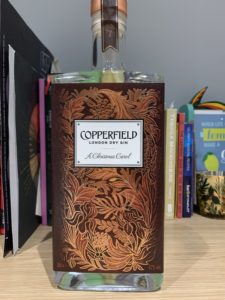 Going full steam ahead, they designed a spirit lab and distillery, ordered two 2 litre and one 20 litre copper pot stills for their gin, plus a second 20 litre still for their vermouth. All are named after literary characters – Tweedle Dee and Tweedle Dum, Alice, and Wendy (Darling), and their branding is an homage to illustrations on antique book covers. Their original London dry gin uses – you guessed it – a historical recipe found in a library archive of pink peppercorns, cubeb berries, rose petals, hibiscus and elderflower. This time we are trying their Christmas gin exclusive to Craft Gin Club members which focuses on cloves, cinnamon, star anise, orange, rosemary and sage. So, how does it taste?
Going full steam ahead, they designed a spirit lab and distillery, ordered two 2 litre and one 20 litre copper pot stills for their gin, plus a second 20 litre still for their vermouth. All are named after literary characters – Tweedle Dee and Tweedle Dum, Alice, and Wendy (Darling), and their branding is an homage to illustrations on antique book covers. Their original London dry gin uses – you guessed it – a historical recipe found in a library archive of pink peppercorns, cubeb berries, rose petals, hibiscus and elderflower. This time we are trying their Christmas gin exclusive to Craft Gin Club members which focuses on cloves, cinnamon, star anise, orange, rosemary and sage. So, how does it taste?
Gallybird Tonic
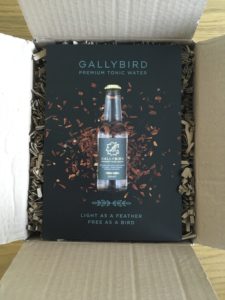 Did you know that some tonic waters have as much sugar in them as a fizzy drink does? With more people watching the calorie count of their drinks, more tonic makers are introducing light versions of their tonic, or making this the centre of their brand. One such brand is Gallybird, who embrace a healthier way of life. Their tonic has no sugar in it, instead they spent two years experimenting in their kitchen in Sussex (hello neighbours!) to make a sugar free, zero calorie, natural tonic water. Instead of sugar, they use Stevia leaf from South America which has been used for centuries and is suitable for diabetics and vegans, as well as containing anti-inflammatory and antioxident properties. So, essentially, it’s good for you. They have designed their tonic to enhance your favourite spirit, rather than overwhelm it.
Did you know that some tonic waters have as much sugar in them as a fizzy drink does? With more people watching the calorie count of their drinks, more tonic makers are introducing light versions of their tonic, or making this the centre of their brand. One such brand is Gallybird, who embrace a healthier way of life. Their tonic has no sugar in it, instead they spent two years experimenting in their kitchen in Sussex (hello neighbours!) to make a sugar free, zero calorie, natural tonic water. Instead of sugar, they use Stevia leaf from South America which has been used for centuries and is suitable for diabetics and vegans, as well as containing anti-inflammatory and antioxident properties. So, essentially, it’s good for you. They have designed their tonic to enhance your favourite spirit, rather than overwhelm it.
Opera Gin
Note: I met the team from Opera gin at Junipalooza and they kindly gave me a sample to try, as always I’ll let you know what I really think.
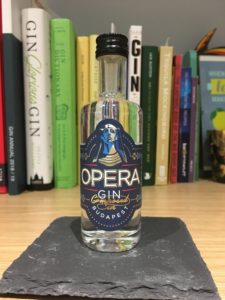 What is Opera gin?
What is Opera gin?
To anyone looking for their next holiday destination, I would recommend Budapest. It’s a lovely city and we had a very fun week there despite falling down the stairs in a ruin pub and spraining my ankle, and falling in the Danube (sprained ankle first). You might wonder why I’m telling you this, but today’s gin comes from that fine city. Fellow WSET student, Balint Damosy (also a lawyer) realised during his training that gin was his passion and spent two years researching and learning about gin, before deciding that launching their own gin was not as insane as they thought. And so Opera gin was born. In April 2018, they received their distilling license to become the first micro-distillery in Hungary, and set up shop in a former cotton factory within the Budapest city walls. They chose to create a traditional London Dry gin as they wanted to create something that was not just high quality, but also true to the spirit. They start with a Hungarian corn spirit before adding standard botanicals: hand picked juniper from the Kiskunság National Park; Bulgarian coriander seeds; angelica; orris root; and liquorice. They then make their gin unique by using citronella grass (which I’ve never come across as a botanical before but feel free to correct me!), lavender, a touch of aniseed and cubeb pepper, and their signature botanical poppy seed. They say this all blends together for a citrus and juniper forward gin that works well with tonic, but also pairs with a dry vermouth to make a crisp martini. So, how does it taste?
Gwyr Rhosili gin
Note: The lovely team at Gwyr gin sent me a bottle to try, but as always I will let you know what I really think.
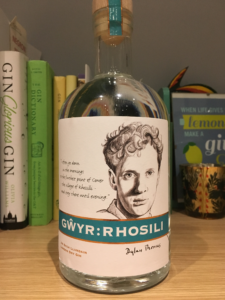 What is Gwyr Rhosili gin?
What is Gwyr Rhosili gin?
If you want to know about Gwyr gin, then I will point you to my posts on their original gin and their Pinwydd edition. Today, however, we are drinking their newest edition to the family, the Rhosili gin. This has been designed with the Dylan Thomas Estate to commemorate the poet’s links with Gower and Rhosili (his body is interred around the coastline in Laugharne). Thomas is most famous for poems such as Do not go gentle into that good night, a poem that has been quoted in numerous shows and films like Doctor Who and Independence Day. So how is this gin different to their others? Where their original gin focuses on pink grapefruit and fennel, the Rhosili edition features foraged gorse flowers, fresh lime zest, sea buckthorn (a botanical that seems to be appearing more and more) and linden flowers. Linden flowers have been used by herbalists for all sorts of things – coughs, colds, high blood pressure and migraines and research has shown that the flowers may have properties that help prevent damage to your liver. Which surely can only be a good thing when added to something that is proven to damage your liver? Please note I am not saying that drinking this is good for you in any way, as always, please drink responsibly. So, moving on, how does it taste?